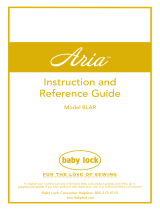
CONTENTS
11
1
2
3
4
5
6
7
8
9
Saving Stitch Patterns in the Computer................................ 179
Retrieving Stitch Patterns from the Machine’s Memory........ 180
Recalling from USB Media.................................................. 181
Recalling from the Computer .............................................. 182
Chapter 5 Embroidery 185
BEFORE EMBROIDERING .................................186
Embroidery Step by Step ..................................................... 186
Attaching Embroidery Foot “W2”........................................ 186
Attaching the Embroidery Unit............................................ 188
SELECTING PATTERNS......................................190
Selecting Embroidery Patterns/Brother “Exclusives”/
Greek Alphabet Patterns/Floral Alphabet Patterns/
Utility Embroidery Patterns ................................................. 193
Selecting Alphabet Character Patterns................................. 194
Selecting Frame Patterns ..................................................... 196
Selecting Patterns from Embroidery Cards ........................... 197
Selecting Patterns from USB Media/Computer..................... 197
VIEWING THE SEWING SCREEN......................198
PREPARING THE FABRIC..................................200
Attaching Iron-on Stabilizers (Backing) to the Fabric ........... 200
Hooping the Fabric in the Embroidery Frame ...................... 202
Embroidering Small Fabrics or Fabric Edges ........................ 205
ATTACHING THE EMBROIDERY FRAME..........206
CONFIRMING THE PATTERN POSITION.........208
Aligning the Embroidering Position Using the Built-In Camera
...... 208
Display the Fabric While Aligning the Embroidering Position
..... 211
Using the Built-In Camera to Align the Embroidering Position
.... 213
Checking the Pattern Position ............................................. 216
Previewing the Completed Pattern ...................................... 217
SEWING AN EMBROIDERY PATTERN ..............218
Sewing Attractive Finishes................................................... 218
Sewing Embroidery Patterns................................................ 219
Sewing Embroidery Patterns Which Use Appliqué .............. 221
PRINT AND STITCH (COMBINING
EMBROIDERY PATTERNS AND PRINTED
DESIGNS) .........................................................223
Selecting a Pattern .............................................................. 224
Outputting the Background Image and Positioning Image ... 225
Printing the Background and Embroidery Position Sheet ..... 226
Sewing Embroidery Patterns................................................ 227
ADJUSTMENTS DURING THE EMBROIDERY
PROCESS ............................................................229
If the Bobbin Runs Out of Thread........................................ 229
If the Thread Breaks During Sewing .................................... 230
Restarting from the Beginning ............................................. 231
Resuming Embroidery After Turning Off the Power ............. 231
MAKING EMBROIDERY ADJUSTMENTS ..........233
Adjusting Thread Tension ................................................... 233
Adjusting the Alternate Bobbin Case (with No Color on the
Screw)................................................................................. 234
Using the Automatic Thread Cutting Function
(END COLOR TRIM)........................................................... 235
Using the Thread Trimming Function (JUMP STITCH TRIM)
.... 236
Adjusting the Embroidery Speed ......................................... 237
Changing the Thread Color Display .................................... 237
Changing the Embroidery Frame Display ............................ 238
REVISING THE PATTERN ..................................240
Moving the Pattern.............................................................. 240
Aligning the Pattern and the Needle.................................... 240
Changing the Size of the Pattern ......................................... 241
Rotating the Pattern............................................................. 242
Creating a Horizontal Mirror Image .................................... 243
Changing the Density (Alphabet Character and Frame
Patterns Only) ..................................................................... 244
Changing the Colors of Alphabet Character Patterns ........... 245
Embroidering Linked Characters ......................................... 245
Uninterrupted Embroidering (Using a Single Color)............. 248
USING THE MEMORY FUNCTION...................249
Embroidery Data Precautions.............................................. 249
Saving Embroidery Patterns in the Machine’s Memory ........ 251
Saving Embroidery Patterns to USB Media...........................252
Saving Embroidery Patterns in the Computer .......................253
Retrieving Patterns from the Machine’s Memory..................254
Recalling from USB Media ..................................................255
Recalling from the Computer...............................................256
EMBROIDERY APPLICATIONS ......................... 258
Using a Frame Pattern to Make an Appliqué (1)...................258
Using a Frame Pattern to Make an Appliqué (2)...................259
Sewing Split Embroidery Patterns ........................................261
Chapter 6 Embroidery Edit 263
EXPLANATION OF FUNCTIONS...................... 264
SELECTING PATTERNS TO EDIT ...................... 265
Selecting Embroidery Patterns/Brother “Exclusives”/
Greek Alphabet Patterns/Floral Alphabet Patterns/
Utility Embroidery Patterns/Frame Patterns ..........................266
Selecting Alphabet Character Patterns .................................266
EDITING PATTERNS ......................................... 268
Moving the Pattern ..............................................................270
Rotating the Pattern .............................................................270
Changing the Size of the Pattern..........................................270
Changing the Pattern Size While Maintaining the Desired
Thread Density (Stitch Recalculator)....................................270
Deleting the Pattern.............................................................272
Displaying Patterns in the Screen Magnified by 200%.........272
Changing the Configuration of Alphabet Character Patterns
.....273
Changing Alphabet Character Spacing ................................273
Reducing Character Spacing................................................274
Separating Combined Character Patterns.............................275
Changing the Color of Each Alphabet Character in a Pattern
....276
Embroidering Linked Characters ..........................................277
Changing the Thread Color .................................................277
Creating a Custom Thread Table .........................................278
Choosing a Color from the Custom Thread Table ................282
Find New Color Schemes With the Color Shuffling Function
......283
Designing Repeated Patterns ...............................................285
Embroidering the Pattern Repeatedly...................................291
Duplicating a Pattern...........................................................293
After Editing ........................................................................294
COMBINING PATTERNS .................................. 295
Editing Combined Patterns ..................................................295
Sewing Combined Patterns..................................................298
VARIOUS EMBROIDERING FUNCTIONS ........ 299
Uninterrupted Embroidering (Using a Single Color) .............299
Basting Embroidery .............................................................299
Creating an Appliqué Piece .................................................300
USING THE MEMORY FUNCTION .................. 306
PRINT AND STITCH (COMBINING
EMBROIDERY PATTERNS AND PRINTED
DESIGNS) ........................................................ 306
Chapter 7 How to Create Bobbin Work 307
ABOUT BOBBIN WORK................................... 308
PREPARING FOR BOBBIN WORK.................... 309
Required Materials ..............................................................309
Upper Threading .................................................................310
Preparing the Bobbin Thread...............................................310
CREATING BOBBIN WORK (SEWING)............ 314
Positioning the Fabric and Sewing.......................................314
Bobbin Work Free Motion Sewing.......................................317
CREATING BOBBIN WORK (EMBROIDERY)
....... 318
Selecting the Pattern............................................................318
Start Embroidering...............................................................320
ADJUSTING THE THREAD TENSION............... 322
TROUBLESHOOTING ...................................... 323
Chapter 8 MY CUSTOM STITCH 325
DESIGNING A STITCH..................................... 326
ENTERING STITCH DATA ................................ 328
USING STORED CUSTOM STITCHES............... 334


























